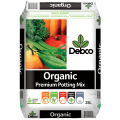

Growing Asparagus In Australia
Asparagus is a classic spring vegetable worth establishing in your garden. You’ll need to wait 2 years from planting before harvesting an asparagus crop - but it’s worth the wait, as Asparagus will be in your garden for the long haul! Each asparagus plant will keep on producing for up to 15 years, sending up tasty green spears in spring and early summer.
Top 5 Steps to Growing Asparagus
- Choose a full sun to part shade position.
- Asparagus will continue producing for many years, so give these plants a dedicated bed or corner of your garden.
- Improve the soil before planting by adding Scotts Performance Naturals Soil Improver
- Asparagus can be grown from seeds (sown in spring) or dormant crowns (planted in winter).
- Asparagus should be fertilised in late winter / early spring and kept well watered.
Prepare to Grow Asparagus
Growing Asparagus from seed
If growing Asparagus from seeds, sow seeds during spring into pots filled with Scotts Performance Naturals Premium Potting Mix. Once the seedlings have outgrown their pots they can be planted into your pre-prepared Asparagus bed. Growing from seed requires patience as the plants won’t be ready to harvest for 3-4 years.
Growing Asparagus from crown
Asparagus crowns are normally sold bare-rooted in winter, ready for planting. As the crowns are already a few years old, they establish quickly in your garden and are ready to harvest 2 years after planting.
Get an Asparagus bed ready for planting by mixing through Scotts Performance Naturals Soil Improver.
Planting
Planting Asparagus crowns
- Dig a trench 15-20cm deep by 30cm wide
- Space the crowns 30-50cm at the bottom of the trench - with each crown sitting on its own mound of soil, so the crown's roots are spread out evenly.
- Backfill the trench to cover each crown with 5cm of soil and continue to backfill as the shoots emerge.
- Once the trench is filled in, top the area with mulch to suppress weed growth and retain moisture.
Remember - for the first 2 years allow Asparagus crowns to complete their growth cycle without harvesting spears. Being patient in these first few years will improve the long term health of your Asparagus plants.
Once your Asparagus has been established for 2 years, it’s time to begin the yearly task of cutting back the fronds each winter. After the edible Asparagus spears finish in summer, allow the tall green fronds to grow and brown off throughout autumn. Cut these fronds off at ground level in winter, and fertilise the area with Scotts Performance Naturals Tomato, Vegetable and Herb Fertiliser. Top this fertiliser with a layer of mulch to suppress weeds and retain moisture. Your Asparagus is then ready for the new round of spears to emerge in spring.
Harvesting Asparagus
Harvest Asparagus spears when they are about the thickness of a pencil. Using a sharp knife cut the spear off at or slightly below ground level. Never harvest spears by pulling on them as you could accidentally pull out the crown or badly damage it.
Asparagus is best harvested in the morning when the spears are sweet and crisp. Spears that are left to grow too fat and too long lose their flavour and become tough. Check on your Asparagus bed daily as the spears will be ready to harvest 2-3 days after they emerge.
Want to try growing white Asparagus? White Asparagus is actually green Asparagus grown in the dark. Try covering an area where the spears will emerge with a black plastic tub or frame covered in dark fabric - the lack of sun stops the emerging spears from turning green, so they’ll remain pure white.
Pests & Diseases
Asparagus is generally a pest and disease-free plant, but keep an eye out for:
- Slugs and snails eat new spears as they emerge. Protect your crop by using beer traps or Defender™ Snail & Slug Pellets.
- Asparagus fronds can be infected with rust, a form of fungal disease. To reduce the risks of this make sure Asparagus is planted in an area with good airflow and avoid overhead watering.
- Crown rot is possible if Asparagus is planted in soil that has poor drainage. If your soils are heavy clay or poor draining, grow Asparagus in raised planters with improved soil or on mounds to aid drainage.
FAQs
When to cut back asparagus in Australia?
In Australia, asparagus should be cut back in late autumn to winter (May to July) once the ferns turn yellow and die off. Don’t rush the cutback—the plant needs time to store energy for next season’s spears. When it’s ready, cut the ferns close to the ground, leaving about 5 cm above soil level to protect the crown.
When is the best time to plant asparagus in Australia?
The best time to plant asparagus in Australia is early spring (September to November) when soil temperatures are above 10°C. However, in cooler climates, planting crowns in winter (June to August) gives them a head start before the growing season. Asparagus loves well-drained soil and plenty of sun, so choose a sunny spot for the best results. In warmer regions, you can also plant in autumn for an early spring harvest.




